| Front Drum Brake Replacement |
| |
As I stated earlier in the buildup and the cost write up, the brakes on the
Jeep were not in the best of shape. In fact, they were really bad. Add to it that there was a manual booster
on the rig and a clogged proportioning valve; it makes for a whole lot of fun.
Since I was trying to stay on a budget in the beginning (yea right...) I figured I would put a power booster in
the Jeep, but I would keep with the drum brakes all around since this was one of the options they offered in 76
on the CJ-5's and I was initially thinking that staying somewhat stock would be a good thing. I set off to do
some research and find out where I could get cheap parts for the rig.
|
| |
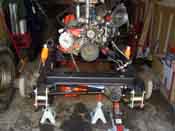
|
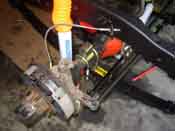
|
| |
| Having recently completed the replacement of the rear drum brakes, I knew that
I could get all the parts from a kit (part# 56215 904) at
Quadratec that came with all the
items in there that I needed to replace the front brake shoes, springs, and clips.
|
| |
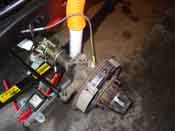
|

|
| |
| I then proceeded with the previous decision to replace the front brake rubber
hoses with stainless steel braided ones as I had done in the rear. This would eliminate the swollen hoses
that I had encountered in the rear and at the same time give a firmer pedal feel when braking. These
were ordered up as well and then I just waited for everything to come in.
|
| |

|
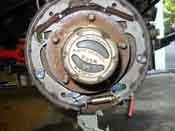
|
| |
| I took everything apart after that. It took me taking off the brake shoes that
were held in place with some springs and the good news was this time around I didn't have to disconnect the
parking brake cables because there are none on the front of the Jeep. Also missing from the equation was the
1-piece axles. This is only a front-end brake job and there was no replacement of the axles upfront since
they don't suffer from the weakness of the 2-piece design.
|
| |
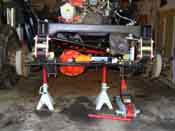
|

|
| |
I then put everything back together the way it came off. I realized then that
I hadn't had the drums cut yet, somehow I forgot, and then I ran down to the local Midas to have this done.
When I came back, I adjusted up the adjusters so there was a slight drag on the drums and I was done.
One tip I learned from the adjusting the rears is to add a bit of grease on the wire that goes around the
curved metal gear. This will prevent binding when the brakes are self-adjusting. I neglected to do this
the first time around and I had to manually adjust the brakes because of debris getting in there.
|
| |
| Lessons Learned the Hard Way |
| |
| So, my lessons learned here would have to be to get all the parts upfront that
you will need to do the job. It might cost more in time and money upfront, but at least you won't be sitting
around waiting for parts to come in and also you won't have to take it apart later to do something that would
have cost a few extra bucks to do upfront.
|
| |
| Conclusions |
| |
I had never done a front drum brake job ever and I was able to accomplish this with
a bunch of reading and snapping some pictures and asking a mechanic friend to review them and tell me if I had done
anything wrong during the setup. Everything turned out good and even thought I was nervous about it, I think
I could rip off a drum brake job in about 30 minutes per side now. Even quicker would be the front since there
are so many fewer moving parts inside there.
The front setup is similar to the rear and took less time since there are no parking brake cables and levers to
have to deal with. After this job was done and I drove it for a bit, I decided to go to a front disc setup.
It really ended up costing me more money when I did this, but I was quite pleased with the results.
One last thing to note. I did a lot of reading about cross-drilling the drums in the front and also in the rear.
Simply put, this puts holes in the drums like they do in the discs. By doing this, any built up gasses, water,
or debris are forced out of the holes during breaking. This helps in water or mud crossings. I tried this and
noticed a bit of difference, but nothing compared to when I went and converted to a front disc setup. You can
do some reading on this if you want to and see what you think. Whatever you decide, brakes are important, so
make sure you don't cheap out and make sure you replace everything that needs replacing. If you don't, it might
mean that you don't stop and all the work you have done on your Jeep will be for nothing.
|

